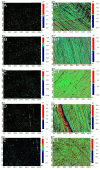Coffee Staining and Simulated Brushing Induced Color Changes and Surface Roughness of 3D-Printed Orthodontic Retainer Material
- PMID: 37177310
- PMCID: PMC10180946
- DOI: 10.3390/polym15092164
Coffee Staining and Simulated Brushing Induced Color Changes and Surface Roughness of 3D-Printed Orthodontic Retainer Material
Abstract
This in vitro study evaluated the influence of combined coffee staining and simulated brushing-induced color changes and surface roughness on 3D-printed orthodontic retainers. Specimens measuring 10 × 10 × 0.75 mm3 were obtained either by conventional vacuum forming or 3D printing at four print angulations (0°, 15°, 30°, and 45°) (n = 10). The prepared specimens were immersed in a coffee beverage and then mechanically brushed using a simulating device. The specimen's color difference (ΔE) and surface roughness (Ra) were quantified using a spectrophotometer and a non-contact profilometer, respectively. The highest and lowest mean ΔE values were recorded for the 3D-printed-45° (4.68 ± 2.07) and conventional (2.18 ± 0.87) groups, respectively. The overall mean comparison of ΔE between the conventional and 3D-printed groups was statistically significant (p < 0.01). After simulated brushing, all groups showed a statistically significant increase in the Ra values (p < 0.01). The highest Ra was in the 3D-printed-45° (1.009 ± 0.13 µm) and conventional (0.743 ± 0.12 µm) groups, respectively. The overall ΔE of 3D-printed orthodontic retainers was not comparable to conventional VFRs. Among the different angulations used to print the retainers, 15° angulations were the most efficient in terms of color changes and surface roughness and were comparable to conventional VFRs.
Keywords: 3D printing; color; orthodontic retainer; stereolithography; surface roughness; tooth brushing.
Conflict of interest statement
The authors declare no conflict of interest.
Figures







Similar articles
-
Effect of print angulation on the accuracy and precision of 3D-printed orthodontic retainers.Am J Orthod Dentofacial Orthop. 2022 Jan;161(1):133-139. doi: 10.1016/j.ajodo.2021.01.020. Am J Orthod Dentofacial Orthop. 2022. PMID: 35012743
-
Comparison of the color stability and surface roughness of 3-unit provisional fixed partial dentures fabricated by milling, conventional and different 3D printing fabrication techniques.J Dent. 2023 Apr;131:104458. doi: 10.1016/j.jdent.2023.104458. Epub 2023 Feb 18. J Dent. 2023. PMID: 36806621
-
Surface Roughness and Color Stability of 3D-Printed Denture Base Materials after Simulated Brushing and Thermocycling.Materials (Basel). 2022 Sep 16;15(18):6441. doi: 10.3390/ma15186441. Materials (Basel). 2022. PMID: 36143757 Free PMC article.
-
Effect of aging and mechanical brushing on surface roughness of 3D printed denture resins: A profilometer and scanning electron microscopy analysis.Technol Health Care. 2022;30(1):161-173. doi: 10.3233/THC-212974. Technol Health Care. 2022. PMID: 34250915
-
Direct 3D-Printed Orthodontic Retainers. A Systematic Review.Children (Basel). 2023 Apr 3;10(4):676. doi: 10.3390/children10040676. Children (Basel). 2023. PMID: 37189925 Free PMC article. Review.
Cited by
-
Digital technology implementation in prosthodontics postgraduate programs in Saudi Arabia: a multi-institutional survey of program directors.BMC Oral Health. 2024 Sep 27;24(1):1136. doi: 10.1186/s12903-024-04908-0. BMC Oral Health. 2024. PMID: 39334330 Free PMC article.
-
Trueness, Flexural Strength, and Surface Properties of Various Three-Dimensional (3D) Printed Interim Restorative Materials after Accelerated Aging.Polymers (Basel). 2023 Jul 14;15(14):3040. doi: 10.3390/polym15143040. Polymers (Basel). 2023. PMID: 37514429 Free PMC article.
-
Effect of post-processing on the surface, optical, mechanical, and dimensional properties of 3D-printed orthodontic clear retainers.Clin Oral Investig. 2025 Jan 6;29(1):48. doi: 10.1007/s00784-024-06120-4. Clin Oral Investig. 2025. PMID: 39760896 Free PMC article.
References
-
- Anil P. Fixed Retention in Orthodontics. Decis. Dent. 2019;5:21–22.
-
- Shopova D., Yordanova M., Yordanova S. Capabilities of Digital Software for Creating a 3D Printed Retainer. Open Access Maced. J. Med. Sci. 2022;10:6–10. doi: 10.3889/oamjms.2022.7874. - DOI
-
- Alshahrani I., Asiry M.A., Altwijry M.K., Premanath S.N., Ramakrishnaiah R., Durgesh B.H. Nanomechanical properties, surface topography, and color stability of fiber-reinforced composite orthodontic retainers. Polym. Polym. Compos. 2019;27:92–100. doi: 10.1177/0967391118819703. - DOI
LinkOut - more resources
Full Text Sources

